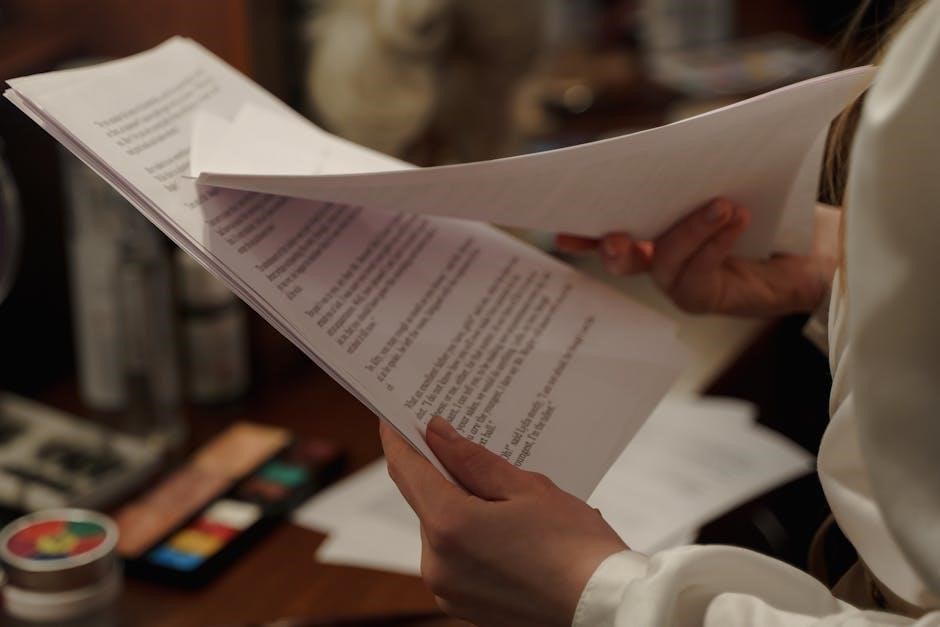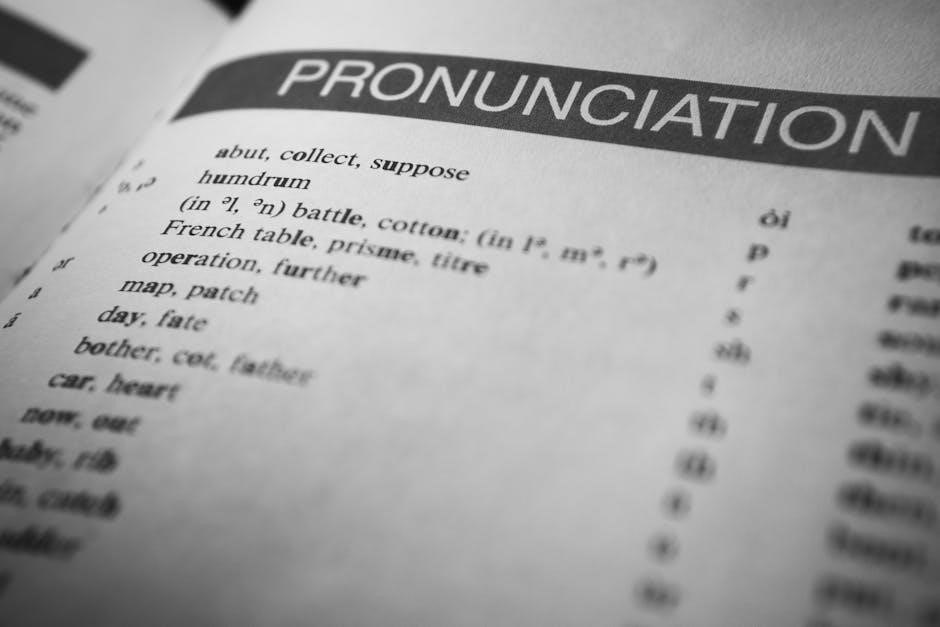Act 3 of Romeo and Juliet marks a pivotal turning point‚ intensifying the tragic conflict and setting the stage for inevitable heartbreak. Tensions escalate‚ and fate accelerates‚ leading to irreversible consequences.
1;1. Overview of the Act’s Significance
Act 3 of Romeo and Juliet is a pivotal section that dramatically escalates the conflict and heightens the tragic tone of the play. This act is central to understanding the characters’ development and the inevitable progression toward the play’s heartbreaking conclusion. Key events‚ such as Mercutio’s death‚ Romeo’s impulsive revenge‚ and Juliet’s defiance of her parents‚ underscore the themes of fate‚ loyalty‚ and impulsive behavior. These moments not only deepen the emotional stakes but also reveal the characters’ true nature. The act’s significance lies in its ability to transform the story from a romantic tale into a tragic exploration of human flaws and societal conflicts. By examining these events‚ readers gain insight into Shakespeare’s masterful manipulation of tension and his exploration of universal themes that continue to resonate with audiences today.

1.2. Key Themes Introduced in Act 3
Act 3 of Romeo and Juliet introduces several key themes that deepen the play’s emotional and philosophical complexity. One prominent theme is the inevitability of fate‚ as the characters’ choices and actions align with the tragic destiny foretold in the prologue. Impulsive behavior is another critical theme‚ exemplified by Romeo’s rash decision to avenge Mercutio‚ which leads to devastating consequences. Loyalty and betrayal are also explored‚ particularly through Mercutio’s unwavering friendship for Romeo and Tybalt’s deadly rivalry. Additionally‚ the theme of societal conflict is highlighted‚ as the feud between the Montagues and Capulets escalates‚ emphasizing the destructive nature of hatred. Lastly‚ the theme of love versus duty emerges‚ as Juliet’s defiance of her parents showcases her commitment to Romeo despite the societal expectations placed upon her. These themes collectively underscore the tragic trajectory of the play and the flaws that lead to its characters’ downfall.

Scene-by-Scene Analysis

Act 3 unfolds with heightened tension‚ as each scene builds upon the escalating conflict and emotional depth of the characters‚ leading to pivotal moments that shape the play’s tragic outcome.
2.1. Scene 1: The Street ‒ Mercutio and Tybalt’s Encounter
In this tense and pivotal scene‚ Mercutio and Tybalt clash on the streets of Verona. Tybalt‚ seeking revenge for Romeo’s presence at the ball‚ challenges Mercutio to a duel. Mercutio‚ known for his fiery temperament‚ accepts the challenge with characteristic bravado. Meanwhile‚ Romeo arrives‚ attempting to intervene peacefully‚ but his efforts fail to prevent the tragic outcome. The duel ensues‚ and Mercutio is fatally wounded by Tybalt’s blade. As Mercutio dies‚ he curses both families‚ foreboding further tragedy. This scene marks a significant shift in the play’s tone‚ escalating the violence and setting Romeo on a path of vengeance. The loss of Mercutio‚ Romeo’s closest friend‚ deeply impacts his character‚ leading to impulsive decisions that drive the play toward its devastating conclusion.

2.2. Scene 2: Capulet’s House ‒ Juliet’s Defiance
In Scene 2‚ Juliet stands firmly against her parents’ wishes‚ displaying unwavering determination. Lord and Lady Capulet‚ unaware of her secret marriage to Romeo‚ announce her engagement to Paris‚ expecting obedience. Juliet’s refusal shocks them‚ revealing her strong will and love for Romeo. Her defiance escalates tensions‚ showcasing her willingness to risk family ties for love. The scene highlights Juliet’s transformation from a submissive daughter to a resolute individual‚ willing to challenge societal norms. Her parents’ anger and threats emphasize the gravity of her decision‚ setting the stage for her desperate plan to escape the arranged marriage. This defiance underscores Juliet’s emotional depth and commitment to her love‚ driving the plot toward tragic consequences.
2.3. Scene 3: Romeo Kills Tybalt
Scene 3 unfolds with heightened tension as Romeo encounters Tybalt‚ who is seeking revenge for Mercutio’s death. Despite his vow of peace‚ Romeo is provoked by Tybalt’s relentless insults and the tragic loss of his friend. In a fiery confrontation‚ Romeo fatally stabs Tybalt‚ an act that seals his fate. This moment marks a dramatic shift in Romeo’s character‚ transforming him from a lovesick romantic to a man driven by vengeance. The consequences of his actions are immediate: the Prince banishes Romeo from Verona‚ leaving Juliet isolated and desperate. This scene underscores the destructive nature of the feud between the Montagues and Capulets‚ as well as the impulsive decisions that propel the play toward its tragic conclusion. Romeo’s killing of Tybalt is a pivotal moment‚ igniting a chain of events that will ultimately lead to the lovers’ demise.

2.4. Scene 4: The Prince’s Reaction and Romeo’s Exile
Following the tragic events of Scene 3‚ Prince Escalus arrives to address the chaos. He is met with the bodies of Mercutio and Tybalt‚ and the tension between the Montagues and Capulets reaches a boiling point. The Prince‚ exhausted by the ongoing feud‚ delivers a stern judgment. Recognizing Romeo’s role in Tybalt’s death‚ he decides to banish Romeo from Verona rather than execute him‚ hoping to quell further violence. This decision devastates Romeo‚ who realizes the severity of his actions and the irreversible consequences of his impulsive behavior. The scene highlights the Prince’s frustration with the families’ endless rivalry and his attempt to restore order. Romeo’s exile sets the stage for the heartbreaking separation of the lovers‚ as Juliet is left to navigate her fate without her husband by her side.
2.5. Scene 5: The Morning After ― Romeo and Juliet’s Final Moments Together
The morning following their secret wedding‚ Romeo and Juliet awaken in each other’s arms‚ basking in the joy of their union. However‚ their bliss is short-lived as Romeo must depart Verona due to his exile. The lovers struggle with the reality of their separation‚ clinging to every moment together. Juliet’s nurse interrupts‚ urging Romeo to leave before he is discovered. Juliet‚ desperate to delay their parting‚ suggests that the nightingale they hear is a lark‚ signaling dawn. Romeo‚ knowing he must go‚ vows to return‚ leaving Juliet alone and heartbroken. This poignant scene captures the depth of their love and the tragic circumstances that tear them apart. The emotional intensity underscores the inevitable fate that awaits them‚ as their bond is tested by the consequences of Romeo’s actions and the unrelenting feud between their families.

Study Guide Elements
This section provides a comprehensive analysis of Act 3‚ including summaries‚ key themes‚ motifs‚ and symbols. It also offers study questions to deepen understanding and prepare for exams or discussions about the act.
3.1. Key Themes and Motifs in Act 3
Act 3 of Romeo and Juliet explores themes of fate‚ impulsive behavior‚ and the destructive nature of hatred. The motif of light and dark imagery persists‚ symbolizing the clash between love and violence. Fate is a dominant force‚ as characters’ choices accelerate the tragic outcome. The theme of loyalty versus betrayal emerges‚ particularly in Romeo’s allegiance to Mercutio and Juliet’s defiance of her family. Impulsive decisions‚ such as Romeo’s killing of Tybalt‚ highlight the consequences of acting without foresight. The recurring motif of time underscores the urgency and inevitability of the characters’ destinies. These elements intertwine to create a tense and foreboding atmosphere‚ setting the stage for the play’s devastating conclusion. By examining these themes and motifs‚ readers gain deeper insight into Shakespeare’s exploration of human nature and conflict.
3.2. Symbolism in Act 3
Act 3 of Romeo and Juliet is rich in symbolism‚ with elements that deepen the emotional and thematic resonance. The sword‚ used in the fatal duel between Mercutio and Tybalt‚ symbolizes both honor and the destructive nature of conflict. Bloodstains on the sword and the ground represent the irreversible consequences of violence and the loss of innocence. The setting sun in Scene 5 symbolizes the fleeting nature of time and the brief‚ shining moment of Romeo and Juliet’s love before it is extinguished. The potion Juliet later considers also serves as a symbol of desperate hope and the lengths one will go to for love. These symbols collectively underscore the tragic inevitability of the characters’ fates and the enduring power of love amidst chaos and destruction. Through these symbols‚ Shakespeare masterfully conveys the intricate emotions and themes of the play.
3.3. Study Questions for Act 3
Act 3 of Romeo and Juliet is packed with dramatic events that shape the play’s tragic trajectory. Here are key study questions to guide your analysis:
- How does Mercutio’s death in Scene 1 influence Romeo’s actions and the overall plot?
- What motivates Tybalt to confront Romeo‚ and how does this highlight the feud’s intensity?
- Analyze Juliet’s defiance of her parents in Scene 2. What does this reveal about her character development?
- How does Romeo’s decision to kill Tybalt differ from his earlier behavior‚ and what does this signify?
- Examine the Prince’s reaction to the duel. What message does his punishment convey about authority and justice?
- Discuss the emotional depth of Romeo and Juliet’s final moments together in Scene 5. What does this reveal about their love?
- How does Act 3 foreshadow the tragic ending of the play?
These questions encourage a deeper exploration of character motivations‚ thematic elements‚ and the play’s dramatic structure.



